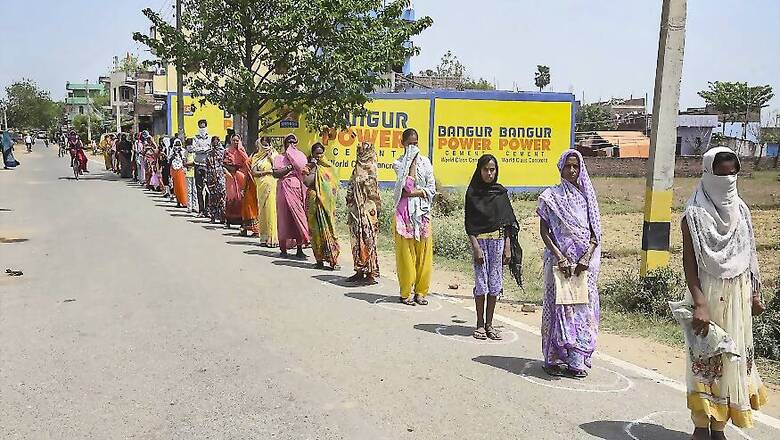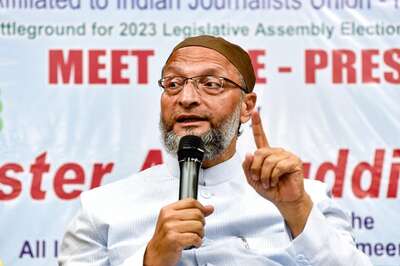
views
Driving from Haryana's Gurugram, Amrinder Singh, 43, had to stop at two borders and produce travel permissions thrice before reaching his sick brother in Uttar Pradesh's Ghaziabad. This was a week before Delhi-Ghaziabad borders were also sealed.
"I used to regularly drive to my brother earlier with no borders of any sort in between. Suddenly after the virus, the division of the national capital region among states seems new," said Singh, who has been with his brother, awaiting travel permissions to go back home.
What was earlier hardly a reminder, borders in India have assumed their most opaque structure ever since the spread of coronavirus.
Over the last few weeks, several models of containment strategies caught the nation’s imagination. Bhilwara in Rajasthan, Pathanamthitta in Kerala, Agra in Uttar Pradesh and Dilshad Garden in Delhi were extensively discussed. But soon we realized how localised this strategy was as the virus spread in Ramganj in Jaipur and the model crumbled.
This again showcased how even within states coronavirus had drawn boundaries in districts. Soon, when the migrants started heading home we came to know how villages were creating borders with bamboo sticks to prevent their entry.
A contagion has divided us like never before. From small towns of India to big cities, as containment zones become extremely localised to colonies and societies, we realised the significance of living in a neighbourhood.
The stark frontier is no more just a physical hurdle but has transcended into avenues of policy and polity thus changing India's age-old concept of co-operative federalism.
India's first Prime Minister, Jawahar Lal Nehru, had in his book, 'The Discovery of India', pointed to the necessity of encouraging co-operation among the provincial governments in the economic and industrial sphere.
A day before his 56th death anniversary, his great-grandson, senior leader of the Indian National Congress, Rahul Gandhi, said, "States are fighting a lonely battle because Central government is not supporting the state governments. Aggressive injection of money is required."
Political analyst Ambikanand Sahay predicts co-operative federalism as we know it is going to change in India forever. “What this pandemic has done has created a lot of grey areas for which neither the state nor the Centre was prepared. These borders are only a means to contain, they will soon evolve into something far more serious in the times to come," he said.
Centre-state relations and inter-state diplomacy
Constructive evaluation of post-pandemic India is raising questions on what it would mean for Centre-state relations, and for national and provincial politics. While the Centre is expected to handle the economic and financial aftermath, the immediate challenge of public health is supposed to be a state burden.
I don't see any constructive discussion between chief ministers. States are in a race to seal borders to show that they have the least number of infected people. States are not coming together to fight the virus - Sanjay Kumar of the CSDS.
"There has been a heightened number of interaction between the states and Centre on how to tackle Covid-19. The administrators have understood that it cannot be a top-down approach to this pandemic and local governments need to take a call. In the last 60 days, the Centre and states have held elaborate discussions on the lockdown, how much of that will continue post coronavirus remains to be seen," said Sanjay Kumar of the Centre for the Study of Developing Societies.
However, the road is far from smooth. Finance Minister Nirmala Sitharman's economic package that conditionally increased state borrowing capacity has drawn flak. Sitharaman had on May 17 raised the state borrowing limit to 5 per cent of GSDP from an earlier 3 per cent with three conditions.
Some states protested the Centre’s move to link the increase in their borrowing limit to reforms, saying it sets a bad precedent. “This is undermining the autonomy of elected governments of states. This is an anti-federalist move,” West Bengal finance minister Amit Mitra had said.
Kerala finance minister Thomas Isaac had said, “Centre has set a bad precedent and in future severe conditions may be imposed on even normal loans.”
In an exclusive interview to CNN-News18, Sitharaman had that the conditions were in favour of the states and that it was their responsibility to plug the gaps.
Meanwhile, the pandemic has also altered inter-state relations.
"I don't see any constructive discussion between chief ministers. States are in a race to seal borders to show that they have the least number of infected people. States are not coming together to fight the virus. There is a unilateral approach to keep away from states that are worse affected in order to keep their numbers low," added Sanjay Kumar of the CSDS.
Blurring lines of state autonomy
Public health and sanitation are matters that fall exclusively within the legislative competence of the states (Entry 6, List II, Seventh Schedule of the Constitution of India).
However, India in the recent past has seen major diversions to the norm.
"The Centre took the decision to impose a national lockdown all by itself. There was no consultation with states," said Kumar.
This was justified by the use of the Epidemic Diseases Act (EDA), 1897, and the National Disaster Management Act (NDMA), 2005, which provides a broad legal architecture to take a variety of emergency measures to contain the pandemic.
Therefore, while health remains a state subject, infectious disease control is in the Concurrent List requiring the Centre's leadership. The 1897 EDA allows both the central and state governments to regulate the spread of epidemic diseases.
The states have voiced further concerns. States’ GST collections have suffered from dues still not disbursed by the Centre. According to the FRBM (Fiscal Responsibility and Budget Management) Act, states cannot borrow from the market over a prescribed limit.
Further, the PM-CARES relief fund has been categorised under Corporate Social Responsibility (CSR) contributions. However, contributions to the ‘Chief Minister’s Relief Fund’ or ‘State Relief Fund for Covid-19’ do not qualify as admissible CSR expenditure thus discouraging donations to any Chief Minister’s Relief Fund.
Also, several Members of Parliament complained that the suspension of MPLADS and diversion of the funds to the Consolidated Fund of India may not be in concurrence of cooperative federalism, as it discourages locally tailored solutions by the MPs.
Public health and sanitation are matters that fall exclusively within the legislative competence of the states. However, India in the recent past has seen major diversions to the norm.
Noted economist and former union minister Yoginder K Alagh said the more India moves over to the rule-based systems – because allocating resources happens from Centre to the states- states get a feeling that they are neglected.
“In the past we have seen how water dispute between two states went up to the Centre when it should be sorted out at district levels and local levels. Spirit of federalism requires working in rule-based systems," he said.
Emergence of the migrant crisis as a unifying failure
A large population in the form of migrant workers fell through the cracks of both Central and state administration. The sudden imposition of the lockdown and sealing of borders by states left crores stranded. MGNREGA emerged as an immediate answer.
Highest-ever allocation of more than Rs 1 lakh crore was made to MGNREGA this year in order to boost employment opportunities in villages and bring relief to migrant labourers.
Announcing the last tranche of the economic package Sitharaman on May 17 said Rs 40,000 crore will be allocated to the Mahatma Gandhi National Rural Employment Guarantee Scheme over and above the budgetary allocation of Rs 61,500 crore.
Eighteen crore person-days of work has been generated so far, which is 40 per cent compared to the same period in the last financial year. Further, it will help in generating nearly 300 crore person-days of work in total and create a larger number of durable and livelihood assets, including water conservation assets.
"The Cauvery formula I had developed in a committee set up by Narasimha Rao suggested the Meking formula - first, negotiate at the local level, then state and finally bring to the Centre. The NDA Act sets up a Central Tribunal for all disputes. Such tribunals take decades,” said YK Alagh.
"Labour laws in India are now being designed for the benefit of industries. Migrant workers in India are terrorised because of what they had to go through. Our laws need to have a very important and compulsory humanitarian angle to them," added Ambikanand Sahay.
Taking suo motu cognizance of the miseries of migrant workers, the Supreme Court after much delay and criticism on Tuesday said there have been “inadequacies and certain lapses” by the Centre and the states and asked them to provide transport, food and shelter immediately free of cost.
Referring to various media reports showing the “unfortunate and miserable conditions” of migrant labourers walking on foot and cycling long distances after the lockdown, the top court issued notices to the Centre, the states and Union territories and sought their replies by May 28.
As India enters lockdown 5 we are seeing how localized dealing with the virus is becoming. First, the state response is based on health infrastructure and manpower resources. A state performance over decades on several social and health indices is deciding how the contagion is behaving.















Comments
0 comment